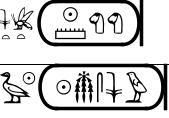New Kingdom - 19th dynasty
[Above - limestone stela depicting Ramessu (I) on the left offering loaves of bread to the god Osiris, taken at the Allard Pierson Museum by Carla Stela reads: "The Lord of the Two Lands, Menpehtire. The Lord of appearances, Ramessu. Given life. Usir, foremost of the Westerners. The great God, lord of the necropolis."]


1st Pharaoh of the 19th dynasty - Ramessu (I) [pictured, above left] [Ramessu, Ramses, Ramesses]
The son of Sethy "Officer of the Charioteers" and Tiu "Lady of the House and Chantress of Ra" (known from an inscription on the 400 Year Stela). Ramessu (I) also had a brother named Khaemwaset "Chief of the Bow of Kush" who was married to a lady called Taemwadsjy.
Ramessu's (I) titles are as follows: Horus name "Khanakht Wadjnisyt" Strong bull who rejuvenate the royalty. Nebty name "Khaemnisutmiatum" Who appears instead of King like Atum. Golden Horus name "Semenma'atkhettawy" Who confirms Ma'at throughout the Two Lands. Throne name "Nesu-bit Menpehtire" The King of Upper and Lower Egypt, Eternal is the strength of Ra. Birth name "Sa-Ra Ramessu" Son of the Sun, Ra begot him.
Ramessu (I) was not of royal birth, he was probably born of a noble family in the Nile Delta area, where he was originally called Paramessu, taking the name Ramessu when he came to the throne. He was originally a military man, where he eventually held the title of "General of the Armies." This is how Ramessu (I) came to inherit the throne, as he was favoured by the previous pharaoh, Horemheb, who died childless. Ramessu's (I) Queen was called Sitre, and they had a son together who was named Sethy, and he served as "Crown Prince." Queen Sitre was buried at Queen's Valley 38. Ramessu's (I) reign was very short, lasting from approximately 1292-1290 BC. Ramessu (I) was buried at Kings's Valley 16, but is believed to have been moved in antiquity to the mummy cache at Deir el-Bahri 320, only to be stolen and smuggled out of Egypt where he was brought to the museum in Niagara Falls. The mummy was then bought by The Michael Carlos Museum at Emory University in Atlanta. Although it is in no way conclusive that this particular mummy is indeed Ramessu (I), scientific testing has provided expected-death dates that are within approximate dates for Ramessu's (I) time of death. Measurements of his skull have also shown a great likeness to that of his son Sethy (I), and his grand-son Ramessu (II), and the style of the mummy's wrappings are very similar to mummification techniques of that period.
Ramessu (I) was not of royal birth, he was probably born of a noble family in the Nile Delta area, where he was originally called Paramessu, taking the name Ramessu when he came to the throne. He was originally a military man, where he eventually held the title of "General of the Armies." This is how Ramessu (I) came to inherit the throne, as he was favoured by the previous pharaoh, Horemheb, who died childless. Ramessu's (I) Queen was called Sitre, and they had a son together who was named Sethy, and he served as "Crown Prince." Queen Sitre was buried at Queen's Valley 38. Ramessu's (I) reign was very short, lasting from approximately 1292-1290 BC. Ramessu (I) was buried at Kings's Valley 16, but is believed to have been moved in antiquity to the mummy cache at Deir el-Bahri 320, only to be stolen and smuggled out of Egypt where he was brought to the museum in Niagara Falls. The mummy was then bought by The Michael Carlos Museum at Emory University in Atlanta. Although it is in no way conclusive that this particular mummy is indeed Ramessu (I), scientific testing has provided expected-death dates that are within approximate dates for Ramessu's (I) time of death. Measurements of his skull have also shown a great likeness to that of his son Sethy (I), and his grand-son Ramessu (II), and the style of the mummy's wrappings are very similar to mummification techniques of that period.

No comments:
Post a Comment